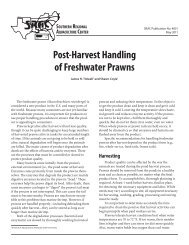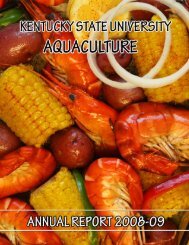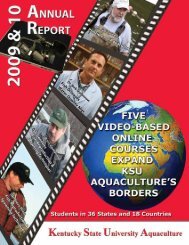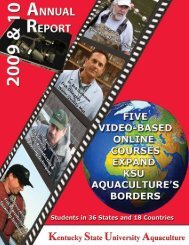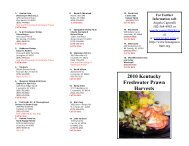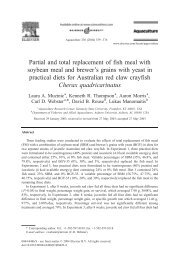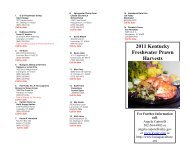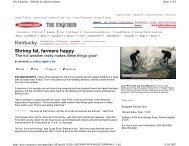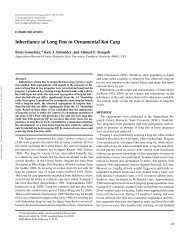Aquatic Weed Control in Ponds - Aquaculture at Kentucky State ...
Aquatic Weed Control in Ponds - Aquaculture at Kentucky State ...
Aquatic Weed Control in Ponds - Aquaculture at Kentucky State ...
You also want an ePaper? Increase the reach of your titles
YUMPU automatically turns print PDFs into web optimized ePapers that Google loves.
proper fertiliz<strong>at</strong>ion program is perhapsthe best method of prevent<strong>in</strong>g the growthof troublesome weeds <strong>in</strong> recre<strong>at</strong>ionponds as well as fry nursery ponds. Toavoid weed problems, establish aphytoplankton bloom as quickly aspossible after fill<strong>in</strong>g the ponds. The bestway to do this is to add <strong>in</strong>organicfertilizers to the pond. The key<strong>in</strong>gredient <strong>in</strong> fish pond fertilizers isphosphorus. The most commonphosphorus source <strong>in</strong> bagged, granularfertilizers is triple superphosph<strong>at</strong>e (0-46-0). It should be noted, however, th<strong>at</strong>when triple superphosph<strong>at</strong>e is broadcastover ponds, it settles to the bottombecause the granules are very <strong>in</strong>soluble.Most of the phosphorus reacts with thebottom mud and never reaches the w<strong>at</strong>er.Any phosphorus th<strong>at</strong> dissolves while thegranules settle through the w<strong>at</strong>er quicklyreacts with calcium <strong>in</strong> the w<strong>at</strong>er and ischanged <strong>in</strong>to unavailable calciumphosph<strong>at</strong>e. Granular fertilizers shouldbe put on an underw<strong>at</strong>er pl<strong>at</strong>form or <strong>in</strong> aporous conta<strong>in</strong>er so they can dissolveslowly <strong>in</strong>to the w<strong>at</strong>er before they contactthe mud bottom.Liquid fertilizers are moreeffective than granular fertilizers <strong>at</strong>stimul<strong>at</strong><strong>in</strong>g a phytoplankton bloom,especially <strong>in</strong> hard, alkal<strong>in</strong>e w<strong>at</strong>ers. Thephosphorus <strong>in</strong> liquid fertilizers is already<strong>in</strong> solution and immedi<strong>at</strong>ely available foruptake by the phytoplankton. Althoughthe phosphorus from liquid fertilizersalso will eventually become unavailabledue to reactions with calcium <strong>in</strong> thepond w<strong>at</strong>er, it rema<strong>in</strong>s <strong>in</strong> solution longenough to be taken up <strong>in</strong> adequ<strong>at</strong>equantities by the phytoplankton.The most common, and best,analysis for liquid fertilizers runs fromabout 10-34-0 to 13-38-0. This generalanalysis of about three times as muchphosphorus (expressed as P 2 O 5 ) asnitrogen (expressed as N) has beenfound to have an excellent balance. Ther<strong>at</strong>e used successfully by manycommercial fish producers is about 1quart per acre applied every other dayfor 3 to 14 days or until a noticeablephytoplankton bloom develops. Liquidfertilizer is heavier than w<strong>at</strong>er, so itshould first be diluted <strong>in</strong> w<strong>at</strong>er before itis applied to the pond, prevent<strong>in</strong>g it froms<strong>in</strong>k<strong>in</strong>g <strong>in</strong>to the bottom mud. It can besprayed from the bank or applied from abo<strong>at</strong> outfitted for chemical applic<strong>at</strong>ions.It should be noted th<strong>at</strong> excessivew<strong>at</strong>er flow through ponds flushes plantnutrients from the w<strong>at</strong>er, favor<strong>in</strong>g rootedweeds th<strong>at</strong> can obta<strong>in</strong> nutrients frombottom soils. <strong>Ponds</strong> should not havew<strong>at</strong>ershed areas larger than necessary toma<strong>in</strong>ta<strong>in</strong> w<strong>at</strong>er level; excess runoff fromlarge w<strong>at</strong>ersheds should be divertedaway from ponds. Spr<strong>in</strong>gs runn<strong>in</strong>g <strong>in</strong>toponds can also dilute nutrients, and theytoo can be diverted away from the pondand can be allowed to enter the pondonly when w<strong>at</strong>er is needed.Manual harvest<strong>in</strong>g. Remov<strong>in</strong>gpotentially noxious emergent weeds byhand is another management practiceth<strong>at</strong> may reduce the possibility of hav<strong>in</strong>gto use chemicals. As small areas of thepond marg<strong>in</strong> become <strong>in</strong>fested, plants areremoved manually. Manual harvest<strong>in</strong>gof weeds is only suited for controll<strong>in</strong>gemergent veget<strong>at</strong>ion <strong>in</strong> rel<strong>at</strong>ively smallponds. Care should be taken to removeas much of the rootstock or rhizome aspossible to m<strong>in</strong>imize re-growth.Mechanical removal of filamentousalgae or submersed plants almost alwaysproves to be futile.Rout<strong>in</strong>e mow<strong>in</strong>g of pond bankswill help prevent the establishment ofdense growths of shorel<strong>in</strong>e plants suchas willows and will also reduce habit<strong>at</strong>for snakes.10



